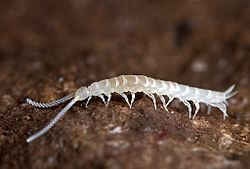Garden centipedes facts for kids
Quick facts for kids Symphyla |
|
|---|---|
 |
|
| Unidentified species | |
| Scientific classification | |
| Kingdom: | |
| Phylum: | |
| Subphylum: | |
| Class: |
Symphyla
|
Symphyla are tiny, worm-like creatures that live in the soil. They are part of a group called Myriapoda, which also includes centipedes and millipedes. Even though they look a bit like small, see-through centipedes, they are their own special group!
Contents
Symphyla: Tiny Soil Dwellers
What Are Symphyla?
Symphyla are small arthropods, which means they have an exoskeleton and jointed legs, just like insects or spiders. They are usually only 2 to 10 millimeters long. They are often called "garden centipedes" because they look similar to real centipedes, but they are much smaller and have a soft, pale body that is almost clear.
Where Do They Live?
These little creatures live in the soil, moving through the tiny spaces between soil particles. You can find them from the very top of the soil down to about 50 centimeters deep. They prefer moist soil and are found in many different environments around the world.
What Do They Eat?
Symphyla mostly eat decaying plants and other dead organic matter in the soil. They help break down these materials, which is important for healthy soil. However, sometimes they can cause problems for farmers. They might nibble on young plant seeds, roots, or tiny root hairs in cultivated fields. This can sometimes harm crops.
Life Cycle of Symphyla
Symphyla go through different life stages. They start as tiny eggs laid in the soil. When they hatch, they are very small juveniles that look like miniature adults but with fewer legs. As they grow, they shed their skin (a process called molting) and gain more legs with each molt until they become full-grown adults.
Images for kids
See also
 In Spanish: Symphyla para niños
In Spanish: Symphyla para niños


